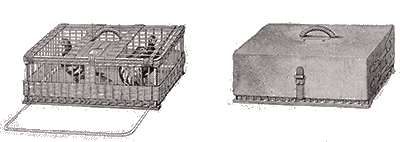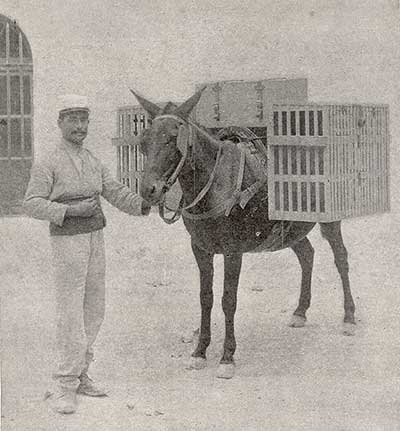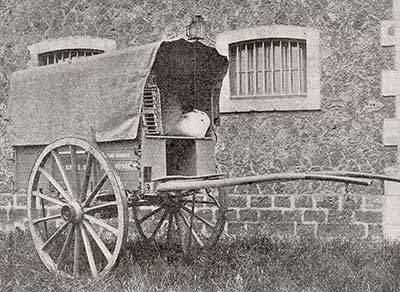

These three pictures from left to rigth show the pigeon with the dispatch placed in the tial. Looking closely at the second photo you will notice that the tube, in which the note is placed, is slipped over a tail feather towards the base The tail feather spreads back out so that the tube will not fall off. The third photo is of a pair of Frence military carrier pigeons.
It might be imagined that the present era of the aeroplane and the wireless telegraph has no use for the swift and faithful winged messengers which rendered such valuable service in the Franco-German and other wars. Many persons, indeed, are convinced that carrier pigeons now serve only for the amusement of a few old fogy sportsmen. These views are quite erroneous. The attention devoted to carrier pigeons by the governments of Europe, and especially by that of France, show that the services rendered by these birds to besieged Paris have not been forgotten, and that at least as great reliance is yet placed upon them as upon the mysterious and erratic Hertzian waves.
At present France maintains twenty-eight military pigeon houses, distributed among the fortifications, especially along the eastern frontier. These establishments, which are in charge of the engineer corps, are devoted to breeding and training carrier pigeons. I have succeeded in obtaining special permission to visit the military pigeon houses of Vaugirard, near the fortifications of Paris, where the system of breeding and training was explained to me by the commanding officer. The reader will be surprised to learn how much care is lavished upon the birds. The soldiers love the pretty little creatures, and follow their educational progress with keen interest.

At Vaugirard, as elsewhere, the pigeon houses are placed on the roof of a building, and each is divided into two compartments by an alley. The floor is composed of plaster, covered with a layer of dry and moderately fine sand, which protects the feet of the birds from fecal defilement. The water vessels are made small in order to minimize the quantity of water which the birds scatter in bathing, but whenever it is possible to nave a supply of running water on the roof of the pigeon house commodious basins are there installed, in which the birds can bathe freely and thus rid themselves of vermin.
In all cases abundant ventilation is provided, about 35 cubic feet of space being usually allotted to each pair of adult pigeons and 9 cubic feet to each young bird. In order to facilitate the circulation of air, the roof of the pigeon house is never plastered, except in mountainous or other cold regions.
The orientation of the house is a matter of importance. Nearly all of the French pigeon houses face approximately north-northeast, or in a direction opposite to most rainstorms. The administration takes care not to place pigeon houses near telegraph or telephone lines, which might injure birds, striking them in flight. Large trees and high buildings are also objectionable because they afford convenient perches for pigeons willing to shirk their flying exercises. The cages are inclosed in glass sashes in order to keep out rodents, and neighboring chimneys are covered with wire netting to prevent young pigeons from falling into them. All of the military pigeon houses are connected by telephone with the offices of the engineer corps.
As a rule, each pigeon house contains 100 pigeons ready for mobilization. To maintain this effective force requires one or two compartments of 130 adult pigeons, a compartment of 200 young birds of the year, two detention pens (one for each sex), which are used only at a certain season, an infirmary facing the south, and a laboratory for the reproduction of dispatches.
The denizens of a pigeon house are selected from birds four or five weeks old, which have not hitherto left their natal house. They are first subjected to four or five days' observation in order to ascertain that they are sound and to supervise their feeding. They are then encouraged to emerge from the house and fly about by allowing them to escape voluntarily, without frightening them, so that they will recognize the entrance door.
This is done about 3 P.M. daily. If the birds were driven out they would probably fly far and fail to return. When adult birds are added to the colony the preliminary training must be greatly prolonged. The newcomers must first be penned up for a considerable time, then mated with older residents, and finally prevented from flying during the entire season by shortening five or six principal feathers of the left wing by about two inches. At the moulting season the amputated feathers are replaced by whole ones. By this time the birds have become accustomed to their new home.
The effective or mobile corps, which in May consists of 100 pigeons from 2 to 8 years old, is increased in October by the addition of 6 reserve birds and 23 young birds, 18 months old, which have taken part in two training campaigns. The winter colony, usually reduced to 130 birds by inevitable losses, produces 200 young for the next season's training.
The pigeons are fed on mixed beans, peas and vetches, which have been gathered a year. The individual daily ration consists of about 1 ½ ounces of this mixture, divided into three meals, given at dawn, noon and 3 P.M. The pigeons are also provided with clay, old mortar, fine river sand, salt and egg shells or oyster shells, ground and mixed in equal parts. This mixture, which is called "salted earth," is left permanently in the cages.
In pairing, care must be taken not to mate two birds of very light coloring, or of very close kinship or strong resemblance. Pigeons differing in color of plumage or eyes should be mated, and crosses should be made between large and small, old and young, shy and tame birds. After marital concord has been established by a few days of enforced cohabitation in seclusion, the couple is allowed the liberty of the compartment. Two eggs are laid within a fortnight after mating and are hatched 17 days later. When the young pigeons are three or four weeks old and have begun to feed themselves they are separated from their parents and placed in a compartment which has a southern exposure and receives the maximum amount of sunlight. The young birds of the second or autumn brood are not usually preserved, because they are less robust and moult abnormally.

The military training of carrier pigeons begins with exercises in flying about the pigeon house. Every bird is required to fly, during an hour at least, twice daily. These trial flights are supervised with great care. When the cages have been opened, the soldiers drive out the pigeons and prevent them from perching on the roof of the pigeon house. The few birds which set a dangerous example to their fellows by alighting on neighboring roofs are shot without compunction. Well trained pigeons have a range of flight which occasionally carries them out of sight. Young birds begin with flights of a few minutes' duration, which is gradually increased to one hour at the age of three months. In order to make the birds understand what is required of them, the same signals are always given for the same evolutions.
The pigeons are induced to leave the cages by shouts, clapping of hands and striking the partitions of the compartments, and they are recalled by whistling, after the mangers have been filled and grain has been strewn on the floor.
The flying exercises are followed by training in carrying dispatches over progressively increased distances. In case of mobilization the pigeons would be transferred to some place which must be kept in communication with the army, in the event of invasion. It would seem logical to carry on the training in connection with this place, where the birds are liable to be confined during several months, when all other means of communication have been destroyed. This procedure, however, is not deemed to be quite regular, and as a rule the practice flights take place in every direction around the pigeon house.
The flights are not attempted in rain, snow or fog. Hence the winter months are deemed unfavorable, while February, March and April are devoted to the foundation and care of the young birds. The training of carriers, therefore, is restricted to the period between April and November.


The pigeons are divided into classes, according to age. Those of the first class, or the corps of mobilization, from 18 months to 8 years old, make daily flights to their place of confinement. They are released singly or in small groups, sometimes all at once, but a rotation of individual flights is carefully observed, in order to subject each bird in turn to this method of training. Some of the pigeons are confined for a long time at the place of mobilization, and even a regular daily service over a given route is maintained for a definite period.
The length of the course is increased from 20 kilometers (12 ½ miles) on the first day to 30 kilometers on the third day, 50 on the sixth, 80 on the fourteenth, 130 on the twentieth, 210 on the twenty-seventh, and 300 on the thirty-fourth.The dispatches are carried in tubes of two sorts. One is a goose quill, 1 ½ inches long and 1/5 inch in diameter. The dispatcher seizes the pigeon with his left hand and presses its breast to his own. Then he separates one of the median tail feathers and passes it through the goose quill by compressing the barbs of the feather, which, when released, resume their normal position. The dispatch is then introduced into the void which the shank of the feather leaves in the goose quill, and is secured with a pointed match-stick. In another method, a tube of aluminium is attached to a leg of the bird, and the dispatch, inclosed in a smaller tube, is then inserted. ' .
Every army carrier pigeon bears certain marks by which it can easily be recognized. The left leg is girdled by an aluminium band bearing the date of the year, the designation of the pigeon house and a serial number. These marks are also stamped on the right wing, together with the letter M or F, Indicating the sex of the bird. Both the sex and the place of mobilization are revealed, furthermore, by a spiral band of colored celluloid borne on the right leg. A male is indicated by 2 ½, a female by 1 ½ spires or turns. There are seven colors: black, white, blue, red, yellow, green and violet, each of which corresponds to a different direction.
In order to complete this brief sketch it is necessary to mention the material equipment employed in breeding and training the carrier pigeons of the French army. This Includes the equipment for the transportation of pigeons, in addition to the equipment of the pigeon house.
As the pigeons are allowed to leave the house at fixed hours only, it is necessary to place, at the entrance of each compartment, special entrance cages, which are set in the windows. These cages are so constructed that the birds can enter freely but cannot escape. The cage is usually 28 inches high, 32 inches long and 28 inches deep. The sides are formed of iron wires about 1 ½ inches apart, and the top is covered with a wire grating, having meshes measuring 4 by 5 inches, an interval sufficient for entrance, but too small for exit. The upper half of the front is like the sides, but the lower half is closed by a movable frame of inverted U-shaped wires, which swing on hinges from the top bar of the frame, the bottom bar of which allows the lower ends of the wires to move inward, but not outward. The returning pigeons, alighting on the board in front of the cage, enter by pushing these swinging wires inward, but cannot escape by the same way. The movable frame is raised by a cord to release the pigeons. The alighting board is made long and conspicuous in order to assist young birds in finding their way home. The breeding nests are arranges in super-posed cells, each of which contains two nests, for the second clutch of eggs is often laid in less than three weeks after the first brood is hatched, and before the young birds are able to feed themselves. The top of the group of cells forms a promenade for the pigeons. The cells are closed, in front, by light wooden gratings, which are easily removed when the nests are cleaned.
The drinking fountains are of the familiar siphon type, and are composed of three-gallon bottles, supported in an inverted position on iron tripods over shallow troughs, into which their mouths dip. The house equipment comprises various appliances, which would interest none except pigeon fanciers.
The pigeons are conveyed from place to place in flat wicker cages. The birds are released for flight by opening a small trap door in the top of the cage. These cages are made in three sizes, which accommodate 25 to 30, 12 to 15, and 4 to 6 pigeons, respectively. The smallest, or training cages, are covered with muslin. The cages are transported by railway, in wagons or on muleback.
The French military authorities encourage the breeding of carrier pigeons as far as possible. French civilians maintain numerous pigeon houses, which are under the supervision of the war ministry, and in which thousands of carrier pigeons are trained. The inhabitants of the department du Nord, like their Belgian neighbors, are enthusiastic breeders of carrier pigeons. The training begins with the advent of warm weather, and almost daily hundreds and thousands of pigeons are sent out, at first to neighboring departments, but later to the center and south of France, where they are released.
The official military recognition of the carrier pigeon dates from the Franco-German war of 1870-1871. Although the birds then employed were poorly trained, they accomplished such remarkable feats that their aid in future wars is relied on with confidence. It is probable that pigeons will soon be carried by aeroplanes, despite the instinctive reluctance of aviators, who regard the birds as dangerous passengers. The rigging of a swiftly moving aeroplane might, indeed, be seriously injured by the impact of a pigeon, and the fouling of the propeller by a bird might be still more disastrous. For the purpose of averting these accidents at the moment of release it has been proposed to drop the pigeon, head downward, through a long vertical tube, so that the aeroplane would be far away before the surprised bird could right itself and begin its flight. This device will be tested by experiment during the coming season.